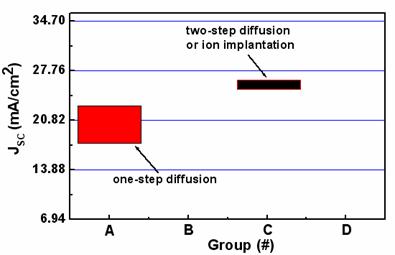|
The solution for low contact resistance of high-efficiency solar power batteries on micro- or nano-wire surface is the key for industrialization of the technique .The solar power batteries research team led by JIA Rui, the research team in Microwave Devices and Integrated Circuits Department (Department 4th) in the Institute of Microelectronics of Chinese Academy of Sciences (IMECAS), has got progress in this research area.
The solar power batteries research team solved the hard problem by the investigation to large-area ion-implantation or diffusion technique. The scientific research proved that the conversion efficiency of solar power batteries can be greatly raised by this means, which can be used in the whole photovoltaic domain.
High-efficiency solar power batteries based on micro- or nano-wire surface is the much-talked-about topic in photovoltaic industrial and scientific research circles. It can increase the absorption and utilization of light, so as to raise the conversion efficiency of solar power batteries on the premise of slightly raised production cost. The solar power batteries research team of Department 4th has greatly raised the capture and absorption of light, by forming micro- or nano-wires on the surface of monocrystalline silicon and polycrystalline silicon. At the same time, the team has led research into the topic “Electrode-contact enhancement in silicon nanowire-array-textured solar cells”. Researchers have solved this difficult problem of lowering the contact resistance on the nanowire-array-textured surface by the achievement ofselective emitter.
The results of experiment indicated, the quadratic selective emitter can be realized by the diffusion or large-area ion-implantation technique, which can raise conversion efficiency of solar power batteries on micro- or nano-wire surface greatly, and also provide a new applicative approach for ion-implantation equipments in the area of realization of high-efficiency solar power batteries. The research achievement has been applied for national invention patent. One of the team’s newly research papers published on J. Vac. Sci. Technol. B 29, 021014(2011) (SCI) has applied this research achievement.

Fig.1 The short circuit gain of highly efficient solar power batteries based on microfiber surface by the new technique (image by IMECAS).

Fig.2 The characteristic curve of one-step diffusion and two-step diffusion to the battery on microfiber surface under illumination (image by IMECAS).
|












